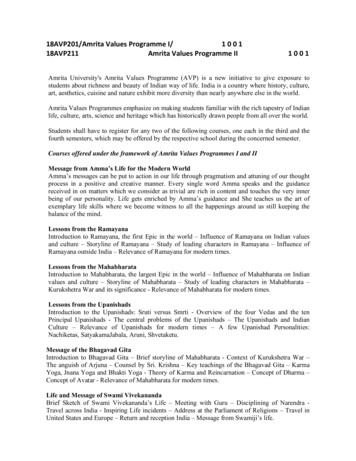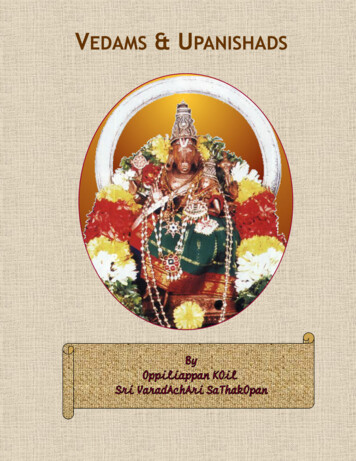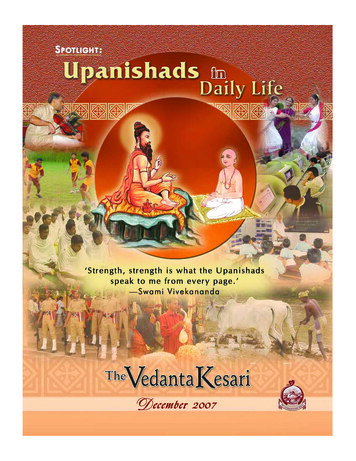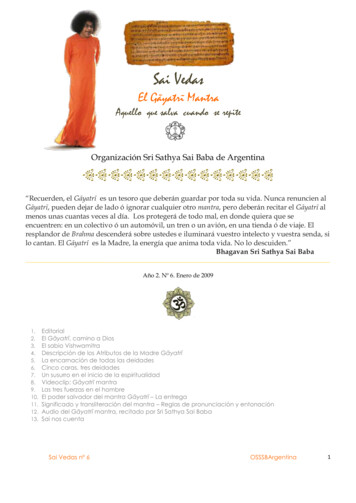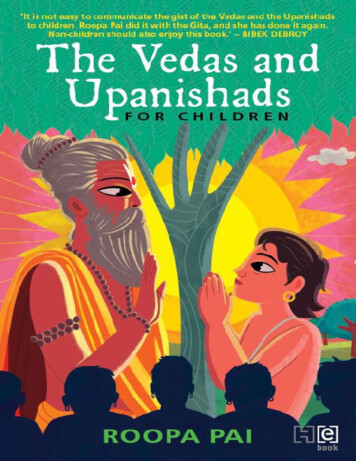
Transcription
The Vedas and UpanishadsFOR CHILDRENROOPA PAIIllustrations by Sayan Mukherjee
First published in 2019 by Hachette India(Registered name: Hachette Book Publishing India Pvt. Ltd)An Hachette UK companywww.hachetteindia.comThis ebook published in 2019Text copyright 2019 Roopa PaiIllustrations copyright 2019 Sayan MukherjeeIllustration on page 55 (top) by Mistunee Chowdhury 2019 Hachette IndiaRoopa Pai asserts the moral right to be identified as the author of this workPhotographs sourced from Wikimedia Commons and attributed on page 412, which is to beconsidered an extension of the copyright page.Wikimedia Commons photographs have been accessed on 26 November 2018 and any changes in thestatus of copyright after this date are not legally binding for any and all versions of this book. Anyomissions are unintentional and regretted, and, following written communication, will be rectified inthe next edition.All rights reserved. No part of the publication may be reproduced, stored in a retrieval system(including but not limited to computers, disks, external drives, electronic or digital devices, e-readers,websites), or transmitted in any form or by any means (including but not limited to cyclostyling,photocopying, docutech or other reprographic reproductions, mechanical, recording, electronic, digitalversions) without the prior written permission of the publisher, nor be otherwise circulated in any formof binding or cover other than that in which it is published and without a similar condition beingimposed on the subsequent purchaser.The views and opinions expressed in this book are the author’s own and the facts are as reported by her.The publishers are not in any way liable for the same.All efforts have been made to verify the copyright ownership of photographs as well as the correctnessof the information included in this edition.Print edition ISBN 978-93-5195-296-1Ebook edition ISBN 978-93-5195-297-8Hachette Book Publishing India Pvt. Ltd4th & 5th Floors, Corporate CentrePlot No. 94, Sector 44, Gurugram - 122003, IndiaOriginally typeset byby Manmohan Kumar, DelhiPrinted and bound in India
by Manipal Technologies Limited, Manipal
To all the readers of this book.Don’t settle for being human – discover the Godthat you really are.
CONTENTSBefore We BeginTHE KNOWLEDGEFirst off, the Vedas1.So What’s the Big Deal about the Vedas?2.Nature Songs of the Cattle-Herders3.The Gods of Big Things4.A-One, A-Two, A-One, Two, Three, Four5.A Feast of HymnsTHE SECRETNext up, the Upanishads6.So What’s the Big Deal about the Upanishads?7.Mastermind!8.Shankara’s Faves – The Top Ten Upanishads9.Isha: The Upanishad of the Sameness of All Things10. Kena: The Upanishad of ‘Whence-Came-It-All’?11. Katha: The Upanishad of the Secret of Eternal Life12. Prashna: The Upanishad of the Peepul Tree Sage13. Mundaka: The Upanishad of the Big Shave14. Mandukya: The Upanishad of the Frog15. Taittiriya: The Upanishad of the Partridges
16. Aitareya: The Upanishad of the Glory of Being Human17. Chandogya: The Upanishad of the Sacred Metre18. Brihadaranyaka: The Great Forest UpanishadAnd, in ConclusionAcknowledgementsSelect BibliographyImage Copyright Information
BEFORE WE BEGINHello, hello! It’s lovely to meet you!You are standing there (or sitting here) reading this for one of two reasons. You have either:(a) bought this book (or your parents have thrust it on you, believing this is an ‘improving’ book), OR(b) you are browsing through it at a bookstore or library, wondering if it’s worth taking home.Whatever your reason, chances are that, like many people, you only have a vague understanding ofwhat the Vedas and Upanishads are. So let’s very briefly ‘define’ the two first.The Vedas are some of the oldest texts known to humankind. They are considered sacred texts andmainly comprise hymns of praise to the elements that sustain us – the sun, the rain, the fire, the wind,the water. Oh, and they came out of the land that we today call India. (To get the Veda 101, flip to TheKnowledge, on page 1.)The Upanishads are part of the Vedas, and therefore, also thought to be sacred. They are the lastand newest ‘layer’ of the Vedas (this is India we are talking about, so even this ‘new’ layer was addedabout 2,700 years ago), but they are not hymns at all – in fact, many are stories, and / or conversationsbetween teacher and student. And what are these stories and conversations mainly about? Unravellingthe answers to very fundamental questions, the kind that human beings of all regions and races havestruggled with forever. Questions that, astoundingly enough, we still have no clear answers to, despiteall the progress we’ve made in the last 3000 years! (To get up close and personal with the Upanishads,go to The Secret, on page 123.)What are some of these fundamental questions? Let’s see now. Where did the universe come from? Who am I? What is the purpose of my life? Is there a God, and if so, who/where/in what form is He/She/It? What is death? How can I be hundred per cent happy all the time? How do I decide what the right thing to do is in a particular situation?(Are these questions that bother you? If yes, keep reading!)Of all the different answers people across the world have come up with to these questions, it seemsthat the old, old answers of the Upanishads are among the most convincing, for a significant number ofIndians – and non-Indians – swear by them to this day. If you’d like to find out what some of those
answers are, this book is a good place to start. You can decide what YOU feel about them once youhave finished reading. You may end up agreeing with the ancients, you may disagree vehemently, oryou may be on the fence, BUT – get this – the sages would be happy with you whichever you are – anagree-er, a disagree-er, or a doubter!To the agree-ers, the sages would say, ‘Glad you agree! But agreeing is not enough. You have to tryout our recommendations – on the secret of happiness, say – and find out if it actually works for you.Oh, and don’t forget to come back and tell us – and everyone else – what you discover, for the point ofknowledge is to share it.’To the disagree-ers, they would say, ‘Wonderful! Why don’t you spend some time thinking aboutthe same questions? Read other texts that have different answers, talk to tonnes of wise people whohave other ideas, process all of it through your own head and heart – and when you think you havesome answers, come back to us? We love a good debate!’To the fence-sitters, they would say, ‘Ah, sceptics! Those who question everything, who will notbelieve what someone else says is the truth, who are not content until they find the answers forthemselves. We totally respect your kind – as long as you just don’t sit there on that fence, but activelyseek the truth yourself. We’d love to know what you find out, when you do!’Because, you see, the sages of the Upanishads were never in the business of making other peoplebelieve what they themselves knew for a fact. Instead, they were ardent seekers of the secrets of theuniverse, and they were on this great quest simply to satisfy their own curiosities. Once the secrets hadbeen revealed to their trained, disciplined minds in a sudden, unexpected flash of inspiration, however,they couldn’t wait to share them with everyone.Here’s the remarkable part, though – these sages did not want wealth, or power, or even fame inreturn. In fact, so unconcerned were they about such things that they did not even attach their names totheir magnum opuses, the hard-won results of their years and years of intense thought experiments!What the sages did hope to achieve by sharing the secrets they had discovered was to inspire peopleto seek the truth for themselves. What they dearly wanted was to help their fellow humans realize thatlife could be a joy if it was lived the right way, and that the human spirit was limitless, chock-full ofuntapped power and potential.My friends, they wanted to tell us, you are all prisoners in a ‘misery yard’, which has such highwalls that you believe, mistakenly, that the yard is the world. But we – we have been beyond the walls,and we have found there a world of utter bliss. You can get there too, and guess what – you don’t evenhave to be dead for that to happen! All you need is the courage to commit to the journey and to all thehardships you will encounter along the way. Here, we’ve drawn you a rough roadmap to that worldbeyond the walls – use it!That’s what the Upanishads are about – a rough roadmap to living in such happiness in this worldthat it begins to feel like Heaven itself. And this little book is a first, very basic key to the map.So, what do you think? Feel like taking a stroll down ye olde Indian route to joy and freedom?What are you waiting for, then – turn the page!
THE KNOWLEDGEFirst off, the Vedas
१SO WHAT’S THE BIG DEALABOUT THE VEDAS?
ight. Let’s kick this section off with a fun quiz, designed to test howmuch – if anything – you know about the Vedas. It’s multiple-choice,and there’s no negative marking, so just go ahead and fearlessly tickthe option you think is closest to the truth. Easy-peasy!PS: The answers come right after the questions. No peeking!R1. So what are the Vedas, anyway?a. The. Most. Ancient. Sanskrit. Texts. Ever. (Also, the most ancientIndian texts ever)b. Among the oldest existing texts in ANY Indo-European language*c. The most fundamental sacred texts of many Hindusd. A vast, and somewhat random, collection of Sanskrit poetry,philosophical stories, spells, incantations, mantras, musical notations,how-to guides for all kinds of rituals, and moree. All of the above*Indo–European languages include, in order of the number of native speakers, Spanish, English,Hindustani (Hindi–Urdu), Portuguese, Bengali, Punjabi, Russian, German, French, Italian, Persian andover 400 more, including – duh! – Sanskrit. PS: South Indian languages are among those classified asDravidian languages.Did you guess (e) – all of the above? That’s the right answer! Bet you gotthat right because you’re the sort of person who picks ‘all of the above’ whenthat option exists. But that’s perfectly fine – now you know what the Vedasare, somewhat.Now, did you notice that the word ‘texts’ was used a lot in the answeroptions? You will be hearing that word a lot in this book – get used to it.Why do we have to call the Vedas texts, though? Can’t we simply call them‘books’ instead? Nope. Because they weren’t really ‘books’ – no one wrote
them out or printed them on paper/birch bark/palm leaves and then bound thepages together. Not for a long, long time, anyway. Plus, the dictionarydefinition of ‘text’ is ‘written or printed work, regarded in terms of its contentrather than its physical form’. That makes ‘texts’ the most appropriate wordto describe the Vedas – and the Upanishads too – because, in the beginning –wait for it – neither had a physical form at all!No, seriously. For almost 2,000 years, the 20,000-plus verses of theVedas were passed from generation to generation purely via oral transmission– they were never written down! Do you realize what that means? Bothteachers and students had to know them by heart! (Want to attempt that as aproject for your next summer vacay?) The oldest Veda, the Rig, was probablywritten down for the first time as recently as 500 CE. What is even morefascinating is the accuracy with which the texts, and the ‘tunes’ they were setto, were conveyed from teacher to student. (How did the ancients ensure thatthe oral transmission of their most sacred texts didn’t turn into a game ofChinese whispers? Find out in ‘Learning the Vedas by Heart (and Ear andTongue and Mind)’ on page 14.) It is those verses, intoned exactly as theywere 3,500 years ago, that you hear at Hindu pujas, weddings and funerals, inHindu temples, schools and homes, and in the ‘Vedic chanting’ classes nowtrending across the globe. Gives you the goosebumps, wot?2. What does the word ‘Veda’ literally mean?a. Holyb. Word of Godc. Knowledged. DutyIf you ticked anything other than (c), sorry! The word ‘Veda’ does notmean Holy, or Word of God, or Duty. The root word of Veda is ‘vid’, whichis also the root word of vidya, which, as you probably know, means
knowledge. (That’s why this whole section is called – ta-daa! – ‘TheKnowledge’.)3. In all, how many Vedas are there? (If you are the sort who paysattention in social sciences class, you’ve got this one nailed.)a. 16b. 4c. 9d. 3Yup, (b) is the right answer. There are officially four Vedas. Inchronological order, they are the Rig Veda, the Yajur Veda, the Sama Vedaand the Atharva Veda (sometimes called the Atharvana Veda). Apparently,this last, the Atharva, is a bit of an interloper that sneaked in later – in the old,old texts, the Vedas are referred to as the Trayi Vidya – the three-foldknowledge, not four-fold.4. Who ‘composed’ the Vedas? (Why is the word composed enclosed inquotation marks? You’ll find out below.)a. A bunch of nameless rishisb. Veda Vyasac. Valmikid. AgastyaAnd the answer is. (a)! Unlike the Mahabharata, which is believed tohave been composed by Vyasa, and the Ramayana, said to have beencomposed by Valmiki, the Vedas were put together, over centuries, byseveral anonymous rishis or sages. However, Vyasa (whose name literallymeans ‘compiler’) is believed to be the one who collected the vast andsprawling body of literature we know today as the Vedas. He then classifiedall the different, random bits of it, decided which portions went together andcompiled those into chunks, and then divided those chunks into four separate
Vedas. For accomplishing this mammoth task in such an efficient, organizedmanner, he was given the title ‘Veda Vyasa’ – the compiler of the Vedas.Oh, and about the quotation marks around ‘composed’. They are therebecause the Vedas are actually considered to be ‘authorless’ – i.e., texts thatwere not ‘composed’ by anyone, not even by that bunch of nameless rishis.Instead, it is believed, the Vedas were revealed to these rishis when they werein the kind of deep trance that is achievable only through years and years ofdisciplined meditation. This makes the Vedas part of what is called Shruti, or‘heard’ literature. In contrast, other ancient Hindu texts, like the Puranas, theRamayana and the Mahabharata, are part of Smriti, or ‘remembered’literature.Hindus believe that Smriti texts were composed by humans, and came outof everything their authors had seen, experienced, understood andremembered. Such texts are allowed to be tweaked, edited, added to and/orrewritten all the time, since everyone’s experience is different, no one’smemory is hundred per cent accurate, and no human work is without flaws.Shruti texts, on the other hand, are believed to contain eternal, universaltruths that could possibly have had divine origins. (Divine origins? Does thatmean the ancient rishis heard the Vedas being recited by a disembodied voicein the sky? Find out in ‘How to “Hear” the Song of the Universe’ on thefacing page.)That’s why it was so important that Shruti texts be preserved exactly asthey were ‘received’. Got that? Good.5. Around how many years ago were the Vedas composed?a. 10,000 years agob. 2,000 years agoc. 5,000 years agod. 3,500 years ago
If your train of thought while answering this question went somethinglike – We’ve already had a, b, c and e as the correct options in previousquestions, so (d) is a dead ringer for the right answer this time, you would beon the right, um, track. The Rig Veda, the oldest of the four Vedas, has beenindeed dated to circa 1500 BCE, which makes the Vedas about 3,500 yearsold.LESSONS FROM THE VEDASHOW TO ‘HEAR’ THE SONG OF THEUNIVERSEFun fact: It involves sacrifices, and ancient rituals likediscipline, focus and a heck of a lot of hard workWe just talked about how the Vedas are part of what many Hindus considersacred literature called ‘Shruti’ or ‘heard’ wisdom, and how it is believed thatthese texts were not composed by humans at all but were revealed (viaconfidential sources, suspected to be divine) to certain rishis who wereconsidered worthy of it.How do you imagine these revelations happened? Did the rishis hear avoice from the sky speaking the Vedas, while bathing them in golden ‘Godlight’? Or was it an inner voice (located approximately in the region of eachrishi’s gut) that revealed the universe’s greatest secrets to him?Metaphorically speaking, neither answer is too far off the mark! It was mostlikely a combination of the two, happening at the same time, give or take theGod-light.
What does that mean? To understand that, you must first understand whothese rishis were. Very often, rishis are depicted as people who grew wearyof the world and its trials and tribulations, and ‘retired’ (notice how the word‘tired’ is already in it?) to the forests to pursue a life of meditation and quietcontemplation. But here’s the thing – true rishis were not escaping the worldat all! In fact, it was the world, with its infinite wonders and apparentrandomness, which fascinated and engaged them more than anything else.These men and women were intellectuals whose thoughts went well beyondthe perimeter of their careers and home-fires and their own small lives. Theseseekers of truth had a burning desire to unlock the mysteries of the world –What is the purpose of life? What happens to us after death? Is there a God?For them, going to the forest was a huge sacrifice, but one they were verywilling to make – it was a way to get away from distractions, so that theycould focus all their energies on this one great quest.When you are willing to make such big sacrifices and are so focused onyour goal, all kinds of magic happens. We see examples of it all around us allthe time, whether we are talking about the greatest scientists or sportspeopleor musicians. Even though science is rigorous, and rational, and methodical,the greatest scientific discoveries are often made by a leap of imagination, an‘I-feel-it-in-my-gut’ sixth sense. The world’s best sportspeople, when theyare in their element, are no longer human but superhuman. The world’s bestmusicians are able to transport us to realms we have never dared to suspectactually exist – places where logic and rationale and science becomeirrelevant and only emotions abound; when the guitarist in your favouriteband gets into his stride at a concert you are watching live, you scream andweep for no reason you can explain, you want to hug strangers.When people talk about such moments, they use the word ‘inspired’ a lot– it was an inspired guess, they may say, an inspired stroke. They cannot
themselves explain how it happened – how they connected two unrelatedthings in a way no one had before, how they knew exactly where to positionthemselves for that ‘impossible’ catch on the boundary. Almost always, theyare also reluctant to take credit for their idea or achievement entirely,especially because they know of so many other talented people who wereworking just as hard as them towards the very same goal, but did not getthere. ‘It suddenly came to me,’ they say, their voices full of wonder, ‘I justknew.’It was possibly the same with the rishis of Shruti literature. One fine day,years and years after they had begun pursuing their quest by doing all theright things – training their minds, learning to focus their energies, notchecking WhatsApp more than once a year, eating right, keeping fit (hey, trysitting – or standing – in one position for hours and hours every day,meditating, and see if you can do it without eating healthy and being fit!) –they had a moment of pure inspiration. They ‘heard’ the song of the universe– the answers to the big questions came to them, they knew.Exciting, right? Now for the more important question. Can you learn howto hear the song too? Can those wise rishis teach you to how to get to thatflash of inspiration in whatever quest of excellence you are engaged in –
math, dancing, poetry, basketball?Before we go there, let us try and understand what inspiration is. In themodern world, psychologists break inspiration down to a combination ofinstinct (a hardwired-in-our-DNA, natural response to the world, which allanimals have, and which comes from inside); reason (a learned response tothe world, which only humans are capable of, and comes from outside); andintuition (or gut-feel, or sixth sense), which is a combination of the two, away to leap from Step A to Step E without ever going through Steps B, C andD.The rishis of ancient India had different words to describe the samephenomenon. They preferred to think of inspiration as a benediction thatcame from a divine source. Was this source outside of them, or inside? Forthe rishis, who believed that the Universal Energy that pervades everything inthe universe (Brahman) was exactly the same as the indestructible energythey carried inside themselves (Atman), the answer was a no-brainer. Fromboth inside and outside, of course!If you think about it, they were completely spot-on. Inspiration – for aplay you are writing for your school’s annual day, your science project, a‘fusion’ dish (like a dosaffle – dosa batter cooked in a waffle iron and toppedwith cinnamon-sugar and ghee) that you have just invented – comes bothfrom outside (let’s say from current affairs, Elon Musk and MasterchefAustralia, respectively) and inside. After all, it is in your mind that youconnect something you already know (dosa) with something you’ve seen on acooking show (waffles). Add your intuition about tastes and textures to themix, and you bring the two together in a unique, special way.But if someone asked you to give them a step-by-step account of how youactually came up with the idea for a dosaffle, would you be able to do it? Notreally, right?
And that’s why, just like a scientist cannot give you a formula for makinga scientific discovery, and a musician cannot tell you exactly how to write agreat piece of music, the rishis of the Upanishads do not pretend that they canteach you how to find inspiration. Like the others, they can only tell you whatthey did to get to that point in their own quest, caution you about thedifficulties you may encounter along the way and give you tips for how to getover them, besides coaching you in technique and ritual and discipline (anddiet!). They might also add an important injunction: Keep your mind open,turn your receivers on, or you may not hear the messages the universe issending you at all! Then, with a pat on your back and a blessing on yourhead, they will send you on your way.Because, you see, the long and winding road to that blinding, exhilaratingstroke of inspiration – Shruti – has to be journeyed alone. You will have tomake the sacrifices, you will have to practise the discipline, you will have tokeep the faith. And then, maybe, just maybe, and only if you are consideredworthy, you will ‘hear’ the universe singing to you. Maybe, just maybe, themagic will happen, and you will be rewarded with the ultimate inspiration –abrief, tantalising, breathtaking glimpse of the Brahman within you, withoutyou.Seems like something worth trying for, don’t you think?LEARNING THE VEDAS BY HEART (ANDEAR, AND TONGUE, AND MIND)Or, how to ensure perfect transmission of knowledgewhen you can’t check back with Wikipedia
How do you make sure great lessons for all humanity stay uncorrupted forthousands of years, when you can’t write them down because your languagehas no script?You would design a system in which only a few were entrusted with thesacred knowledge. You would put the chosen ones through years of intensetraining. And you would create a fail-proof (or close enough) system toensure that they retained everything they had learnt.And that’s exactly what the Vedic seers did – they created the ultimateancient Indian coaching class! It was called the Vedic gurukul. What were themain features of this ancient school? Read on to find out.1. A most stringent admission process. The gurukul entrance test wastough as nails and completely transparent – gurus interviewed eachcandidate, evaluating each one on his inclination for hard work, ability tofollow instructions and aptitude for this particular kind of rigorous study(with bonus points awarded for a naturally curious and questioning mind)before deciding which ones to pick. There was also the small matter ofeligibility – only boys, and that too only brahmin, kshatriya and vaishyaboys,* were eligible to apply. (Shudras were kept out of the admissionprocess entirely. Not many girls lined up for admission either, but thethirty-one women rishis on record indicate that they were not entirelyabsent.)*The four main varnas, or occupational groups – today, the word ‘caste’ is used to mean varna – inancient India were the brahmins (scholars and thinkers), kshatriyas (kings and warriors), vaishyas(merchants and farmers) and shudras (craftsmen and labourers). While boys of the first three varnaswent into gurukuls for their education, shudra boys – sons of potters, carpenters, weavers, goldsmiths,leather workers, sculptors and others who worked with their hands, went into ‘vocational training’ withtheir dads and uncles and learnt the family trade. Girls of all varnas learnt to cook and keep house withtheir mothers, apart from training in music, art and dance.If you believe academic learning is superior to every other kind, this sounds like girls and shudrasbeing ‘relegated’ to the B league. However, many modern educationists firmly believe that a ‘holistic
education’ is one that gives the arts and crafts as much importance as academic learning, for it creates amore equitable society, where ‘makers’ – sculptors, weavers, chefs – and artistes – dancers, musicians,designers – are respected just as highly, and paid as much, as professors and bankers and softwareengineers. Food for thought, eh?The real downside of the gurukul system was that a lot of scary-smart girls and shudras never gotthe opportunity to try their luck at academics. And although some gurukuls also taught the arts andcrafts, it is likely that many brahmin and kshatriya boys keen on dance and jewellery design did notfind avenues to explore their creativity.Sure, there is far less discrimination today on the basis of gender and caste in education, but overall,is the 21st century world less discriminatory than the one 3,500 years ago? What do you think?’2. Loads of extracurricular activities. Boys were admitted into the fullyresidential programme when they were around twelve years old, andparents were informed that they could pick up their wards from thegurukul main gate at noon, exactly twelve years later. Until then, studentsoccupied themselves not just with studying the scriptures but also helpingthe guru’s wife around the house, herding and milking the cows, tending tothe farm and vegetable patch, collecting and chopping firewood, andserving their foster parents (did you think they were lucky to get awayfrom annoying parents for twelve whole years? Ha! In life, there is neverany getting away from parents) in whatever ways they could.When they left the gurukul, most of the raw, unschooled twelve-yearolds had transformed into well-read, well-mannered, self-reliant youngmen who were proficient in debate, logic and critical analysis. Theyrefused to accept ‘facts’ without examining and questioning them, butwere open to changing their opinions on things as and when they cameacross convincing new data. They could think for themselves, live withoutluxuries and do all the work around the house (although they usuallyended up letting their wives do it as soon as they were married).3. Small class sizes. Most gurus took no more than twelve students everytwelve years. Apart from the minor difficulty of feeding twelve growing
boys (gurukul education was absolutely free) and figuring out where theywould sleep, teachers preferred a small student group so that they couldgive each boy their full and focused attention. Also, since a lot of learningwas based on hearing – very, very clearly – every word the guru said, asmall class made sense.4.The right learning environment. Nope, they weren’t thinking airconditioned school buses or ‘smart classrooms’, actually. Gurukuls wereusually located deep within quiet virgin forests, far away from thedistractions of city and village life. Living and studying in the midst ofnature and observing her in her many moods and seasons developed in thestudents a deep and enduring love for her, and a sense of oneness with the
vast and wondrous universe they were part of – which was one of the main‘desired learning outcomes’ of Vedic education in the first place.5. Get the basics right. Here’s an important fact – as far as the Vedas areconcerned, it isn’t just the words but also their sounds, and tones, that areconsidered critical to the meaning and power of the verses (that was part ofthe reason they continued to be taught by a guru well after scripts weredeveloped and the verses were written down). Since each syllable of theverses was supposed to be pronounced a particular way, sung at aparticular note position and held for a particular duration, teachingstudents the right way to chant each hymn and mantra was vital. Once theyhad got this bit right, students went on to the next phase: training anddisciplining their minds through – here’s the fun part – memorization* ofthe Vedic hymns.Only when they had done years of this did students get to morecomplex stuff like logical thinking, critical analysis of texts, introspection,the art of (respectful) debate, and so on.*Ever wonder why ‘mugging’ and doing over and replicating the teacher’s notes – to the last word – inthe exams is such a big part of the Indian education system? It’s tradition – that’s the way things havebeen done for 3,500 years! Now you know.6.Patterns and sequences, tricks and techniques! Straight-upmemorization is one thin
Right.Let's kick this section off with a fun quiz, designed to test how much - if anything - you know about the Vedas. It's multiple-choice,
